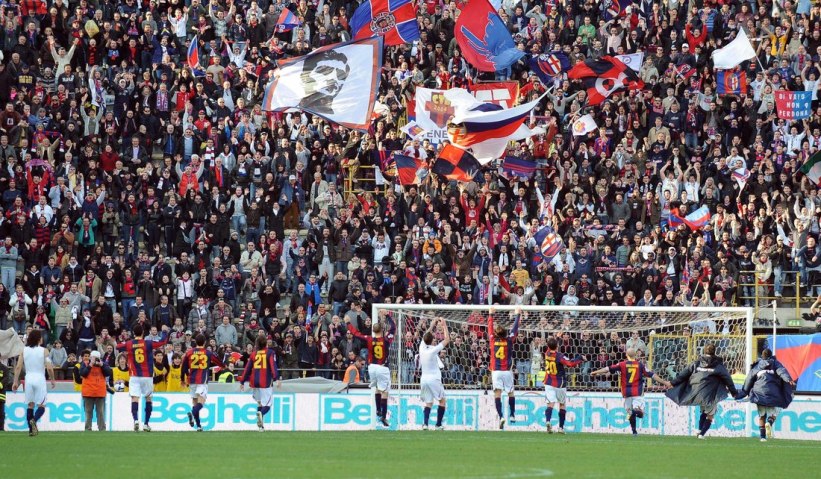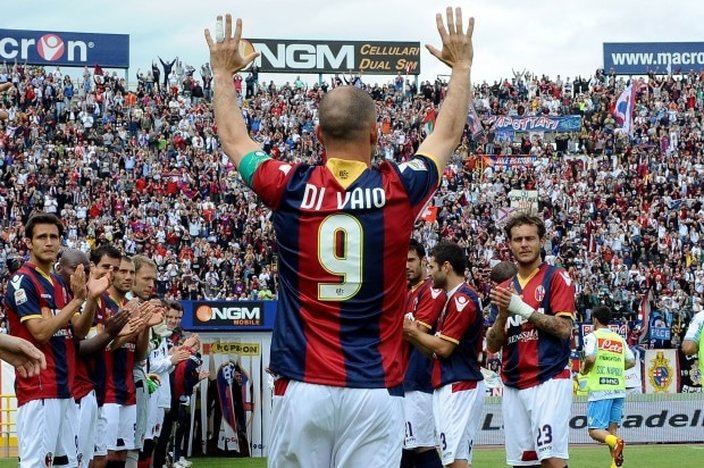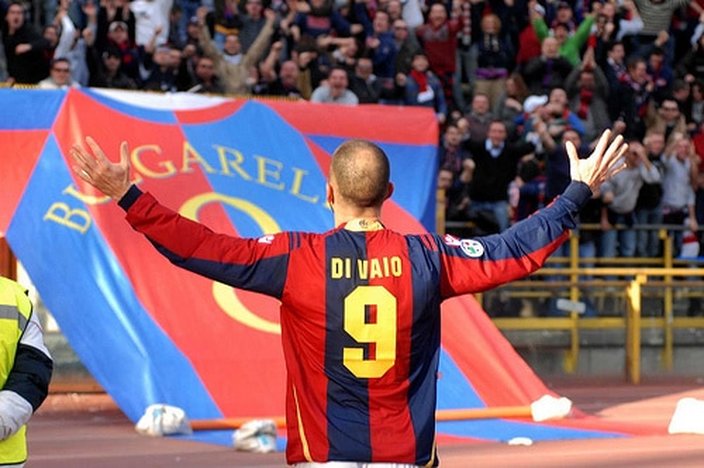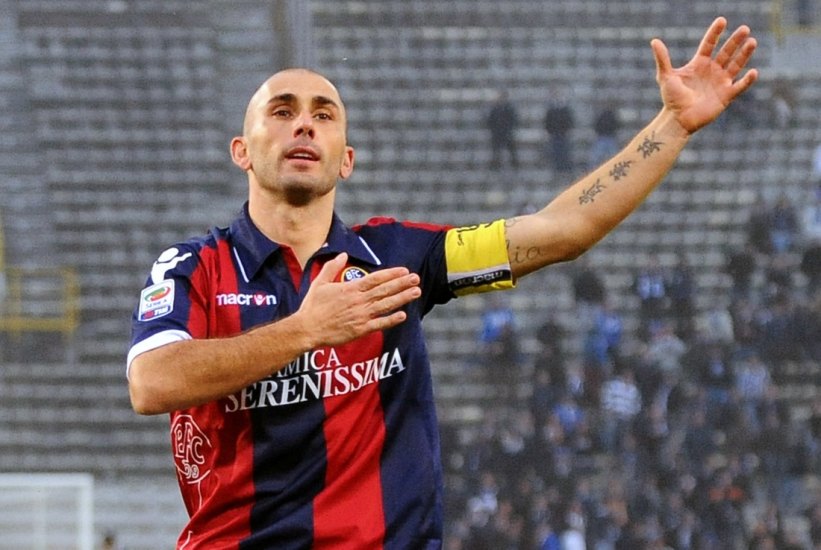These days, it is rare for fans to hold a player in such high regard; to see an individual player as an embodiment of their club. It is even more rare if this particular player has not been at the club for all of their career. Marco Di Vaio joined Bologna aged 32, but he soon became an icon in the city, and his presence is still felt to this day.
The journeyman tag is often looked upon with shame. A mark of underachievement – a sign of never fitting in or settling down. As Di Vaio turned up for his first day at Bologna’s Casteldebole training ground in 2008, it was this mark that casted a shadow over him.
If footballers’ careers were based on their CV, then Di Vaio would have been regarded in much higher esteem. Di Vaio first shone at Salernitana, as the side gained promotion to the top flight in 1998, with the forward finishing as top scorer in Serie B. He then spent his formative years at Parma, towards the end of their glory days. It was in Emilia-Romagna that Di Vaio’s promise began to flourish, after less successful spells earlier in his career at the likes of hometown club Lazio and Hellas Verona.
With a reputation as a clinical goal scorer, Di Vaio was hot property in Serie A. At Parma, he won the Coppa Italia and Supercoppa Italiana, and like other Italian youngsters including Gianluigi Buffon and Fabio Cannavaro, Di Vaio’s talent came to the fore. His big break came in the summer of 2002, securing a €26 million move to Juventus, where he joined former Parma teammates Buffon and Lillian Thuram.
Having been deadly at the Gialloblu, most expected Di Vaio to continue in a similar manner at the Stadio delle Alpi, especially given the quality of the supply line at the club. But it was not to be. Just 18 goals in two seasons, two less than his final campaign alone at Parma, was the most telling – and damning – statistic during his time at the Bianconeri.
Despite making 11 appearances en route to the all Italian Champions League final at Old Trafford in 2003 (against AC Milan), Di Vaio was dropped for the final. It was a decision that would take him years from which to recover. A year later, when Fabio Capello brought Zlatan Ibrahimovic to Turin, Di Vaio was shown the exit.
Spells abroad at Valencia and Monaco followed. However, while Di Vaio added to his domestic trophy collection, his career was stalling and he lost his place in the Azzurri squad. In truth, his career with the national side never really took off. Di Vaio made his debut under Giovanni Trapattoni in 2001 and went on to play 14 times for his country. His last appearance came in a seven minute cameo in 2004, but with the youthful pair of Luca Toni and Alberto Gilardino stealing the headlines, Di Vaio’s time was up.
It appeared that the Roman born forward would forever be remembered as a wasted talent, never able to recreate his dynamic form at Salernitana and Parma. However, a lifeline and a return to Italy was thrown his way by Genoa. But Di Vaio failed once again to live up to expectations, and though he was part of the side that earned promotion to Serie A in 2007, he only managed nine goals in the second tier. In Serie A the following season, he scored just three times.
Things could hardly get worse. The struggling striker was once again showed the door, but this time it looked like it might be for the final time. Footballers don’t often get a second chance, let alone a third and fourth one. But in Bologna, Di Vaio found a perfect fit. To understand why, one has to comprehend the history of not only the club, but also the city.

Click to read ‘Bologna: The Alternative Club Guide’
Bologna has often struggled with its place in Italy’s socio-cultural and political landscape. It often does things differently. During the Middles Ages, it was one of the biggest cities in Europe. Famed for its historic university – the oldest in Europe – it was a learned place and soon became regarded as a sanctuary for those who did not align with the mainstream.
Nicknamed La Rossa, the Red city, in reference to the iconic red roof tops, the nickname also reveals its political tradition. During the fascist regime – despite Mussolini’s best attempts – Bologna was often seen as the centre of opposition, culminating in the city being at the heart of the resistance during the war. During Italy’s internal Cold War, which came to the fore during the 1948 elections, Bologna was seen as a bastion of the political Left, opposing the western backed conservative parties which dominated the political system up until 1991.
Bologna as a city felt left behind; without a voice. Its once famous football club has mirrored this trend. Having been formed in 1909, it did not take long for Bologna to establish itself as a power within Italy. With the goals of Angiolino Schiavio, who remains the club’s all-time top goal scorer, the Rossoblu claimed their first Scudetto in 1925.
The magnificent 1930s’ followed, leaving Bologna with five domestic titles, which were added to in 1941. Yet since then, the Red and Blues have only won one Serie A crown in 1964, which owed much to the club’s then engimatic captain and all-time record appearance holder, Giacomo Bulgarelli. Since then, Bologna’s has been a story of decline and in 1982, despite the emergence of a young Roberto Mancini, the club was relegated for the first time in its history.
One year later, Bologna were playing in Serie C. It was an all-time low for such a historic club. The pattern repeated itself in the early 1990s’, as the club fell from the top flight to obscurity in a matter of two seasons. With the cementing of modern Italian super clubs like Roma and Lazio, the club from Emilia Romagna were left behind, seen as an institution of past glories.
A rebirth was required. Under ambitious president Giuseppe Gazzoni, Bologna came back once again. Years of mid-table security in the top flight followed, only to be interrupted by relegation in 2005, which saw a nine-year spell in Serie A come to an end. When Bologna returned in 2008, the club sought a leader on the pitch to help secure their top-flight status. They chose Marco Di Vaio.
Bologna’s capitano shared a special relationship with the Rossoblu faithful
Quickly, the former Parma man found his feet at the Rossoblu. Like the club, he had a point to prove, to show that his best days weren’t behind him. He scored more times during his debut campaign than at any other time during his career. His haul of 24 goals not only helped Bologna secure safety with a 17th place finish, but was only bettered by Inter’s Zlatan Ibrahimovic, who managed just one more than the veteran Italian striker.
Following his heroics, Di Vaio was given the captaincy just 12 months after he joined the club; a testament to his instant impact at the Stadio Renato Dall’Ara. In a carbon copy of the previous season, it was Di Vaio’s goals that were vital to the side’s continued survival in Serie A.
As his stock rose, rumours of a transfer away from Bologna gained traction. Links to former club Lazio persisted, but the Rossoblu’s newly adopted hero refused to move. It was a decision that almost certainly cost him a chance of returning to the Azzurri fold, but the forward never forgot the chance Bologna had given him.
A bond between Di Vaio and the supporters in Bologna’s Curva Bulgarelli grew. As they fell in love with him, Di Vaio fell in love with the city. “I owe everything to this city and its people,” the Italian bomber said. “There is a great passion and history in Bologna, and I am so lucky to be part of it.”
In his four years at Bologna, Di Vaio finished each season as the club’s top scorer. During the 2011-12 campaign, the Rossoblu finished in the top half under the stewardship of Stefano Pioli, and with the talented duo of Alessandro Diamanti and Gaston Ramirez. Yet it was Di Vaio who played in every match. In fact, over four seasons, he missed just nine games. An incredible feat for a player in the twilight of his career.
Though a fairy-tale ending of retiring at the club was not to be, Di Vaio was awarded a heroes’ send off. During his last game at the Dall’Ara, a guard of honour was laid out for Bologna’s Di Vaio, whilst the ultras in the Curva Bulgarelli displayed a banner reading: “Marco, an eternal thank you. You leave the field, and enter into legend,”
 Di Vaio recieves a guard of honour during his final game at Bologna
Di Vaio recieves a guard of honour during his final game at Bologna
Di Vaio left the club in the summer of 2012 to enjoy a successful spell in Major League Soccer at Montreal. In Canada, he would once again be the leading man and enjoy a strong relationship with the home faithful.
Following his retirement in 2014, Di Vaio became Bologna’s club manager in a happy return to his adopted footballing home. In the role, which he still holds today, the former forward looks after affairs both on and off the pitch, once again being a central part of the club.
Many will look at the career of Di Vaio and wonder what might have been. He should have scored and won more, and perhaps even been part of Italy’s World Cup winning side of 2006. Yet, although it took him many years, he found his true home in Bologna. Di Vaio represents the true spirit of the city and the club. And it is this fighting spirit and refusal to lay down that ensured he became a bandiera and embodiment of the Rossoblu.
Words by Richard Hinman: @RichardHinman
’Richard has been an avid follower of Italian football since the turn of the century and in particular Roma’s dramatic final day Scudetto triumph. A Yorkshire man with Calabrian roots, he is passionate about writing on all things calcio, from its historic players to current issues.’


